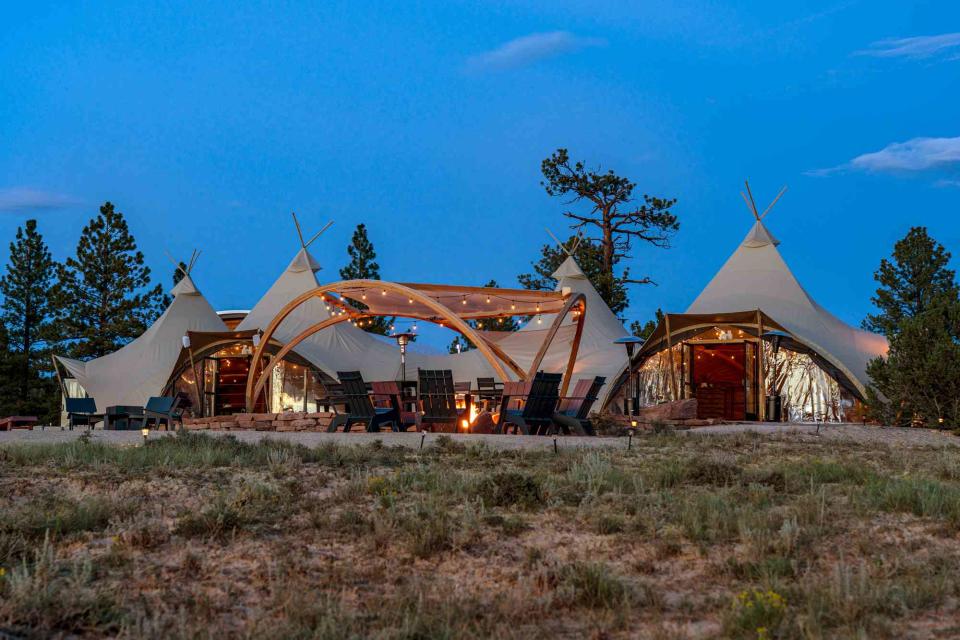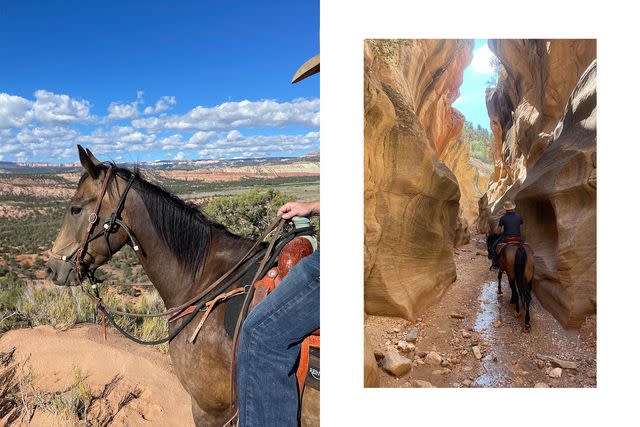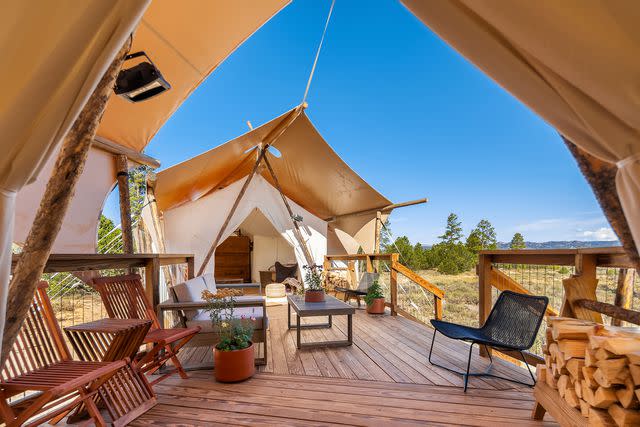This Luxury Glamping Retreat Near Utah's Bryce Canyon National Park Has Horseback Riding, Canyoneering, and Stargazing
Under Canvas Bryce Canyon has no shortage of outdoor thrills — or creature comforts.

BAILEY MADE/COURTESY OF UNDER CANVAS
The firepit beckons at Under Canvas Bryce Canyon.“This’ll be a chance for you to really cowboy,” said Joseph Steed. “We’re going off-road.”
I was sitting horseback on a ridgetop outside Tropic, a dusty Utah town 10 miles from Bryce Canyon National Park. Before me was a vista straight out of a Pixar film: miles of silver-green sagebrush extending to distant plateaus, chalked pale pink and white by minerals in the rock. Beyond them was Bryce Amphitheater, a massive chasm where spindly sandstone rocks called hoodoos rose up like church spires. There was no road or path, or even a line of footsteps, in sight.
I had gone to Utah in September with hopes of leaving my New York City life behind — if only for a long weekend. A new glamping site, Under Canvas Bryce Canyon, had opened a month earlier, promising travelers access to the area’s biking, climbing, and hiking, along with luxuries like king-size beds and a gift shop stocked with Lululemon. After checking in, I’d asked for horseback-riding recommendations, and soon after, I swung into a saddle next to Steed, who runs Western Canyons Trailrides.

Courtesy of Samantha Falewée
Saddling up with Western Canyons Trailrides; riding through a canyon.Over the next eight hours, we rode through undulating slot canyons so narrow the sandstone brushed my knees, navigated wet creek beds, and climbed dusty hills to views that again and again defied description. I chewed on lemon-pepper jerky as Steed (I asked if that was his real last name; he assured me it was) relayed exploits from his life: breaking mustangs, running cattle drives, guiding mules up and down the Grand Canyon.
“One thing to remember,” Steed said, peering out from under the brim of his cowboy hat. “You can’t do this lifestyle if you don’t love it. It has to be a choice. Otherwise it’s too tough.” My knees throbbed in agreement, a sure sign I’d be sore tomorrow.
"Over the next eight hours, we rode through undulating slot canyons so narrow the sandstone brushed my knees, navigated wet creek beds, and climbed dusty hills to views that again and again defied description."
But thankfully for my legs, the comfort waiting for me back at Under Canvas swept every ache aside. After my ride, I met guest experience supervisor Matt Norton outside the lobby tent for a tour of the solar-powered, 700-acre property. Around us, three firepits and ample seating filled the outdoor rec area, which was bathed in cool pink-blue as the sun set behind the Dutton Range. That night the restaurant was serving roasted trout with farro and slow-cooked greens and braised chicken thighs with polenta, mushrooms, and basil.
Norton showed me to my tent, a sprawling Hoodoo Suite, which sleeps six. It had a private porch, firepit, and a cooler stocked with kombucha and nonalcoholic spritzers (the site now also offers beer and wine). Inside was a king-size bed, along with a sofa bed and chairs, lanterns, a wood-burning stove, and charging ports. (Wi-Fi is intentionally not available at any Under Canvas property.) There was also a full en suite bathroom, with a pull-chain shower to reduce water waste.

Bailey Made/Courtesy of Under Canvas
The Hoodoo Suite at Bryce Canyon Under CanvasThe tent had screened windows with canvas covers. I immediately unzipped them. Norton pointed to a ponderosa pine that stood next to my porch. “The bark smells like butterscotch,” he said. I leaned in close to the flaky tree trunk and inhaled. He was right.
The next day, after an almond-milk latte at the coffee bar, I went canyoneering in nearby Kane County. Mike Dunn from Zion Guide Hub had agreed to teach me how to clip into a harness and scale down 70-foot sandstone cliffs. I had not, however, revealed that I was afraid of heights.
“If you need them, remember my car keys are under the bumper by the left headlight,” Dunn said, minutes after we’d met.
I blinked at his words as I hefted my helmet and a backpack full of gear. We were in a scrubby forest of juniper trees and sage brush, red sand clinging to our boots. It was just the two of us. Was this in case something happened to him? I asked. Dunn laughed, but didn’t deny it.
"I saw two shooting stars, each a quiet thrill. But my gaze kept returning to the Milky Way. It stretched over the entire sky, almost reaching both ends of the horizon. How many years had it been since I’d looked at it?"
We hiked to the top of our first canyon, the Huntress, while Dunn told me about the sport. Technical climbing, with the use of harnesses and anchors bolted into the stone, became popular in the U.S. during the 1970s, particularly in this part of Utah, which has some of the tallest sandstone walls in the world. Dunn himself has scaled several of them — in 2021, he and his climbing partner, Ky Hart, completed the debut ascent of the eastern face of a mountain known as the Altar of Sacrifice. The 2,200-foot climb took seven days to finish. As the first recorded climbers to reach the top, Dunn and Hart had the honor of naming their route. They called it “Cowboy Killer.”
To my great surprise, I enjoyed canyoneering so much that the palm-sweating terror I normally associate with heights never set in. Dunn taught me to lean back into my harness and position my legs perpendicular to the cliff so my feet could rest firmly on the rock face. Because of recent rains, sometimes our descents ended in water. As I squished my toes around in my sopping wet shoes and looked down at the mud covering my legs, I began to feel a childlike sense of elation.
Related: 5 Expert Tips for Visiting Utah's 'Mighty Five' National Parks
That evening, I was happy to loll around the communal area, inhaling the smell of campfire smoke. As daylight faded, I thought longingly of the bed in my tent. But there was one more thing I wanted to try. I walked up a hill to join a small group clustered around a telescope trained on Jupiter, which burned white-orange over the tree line. Someone pointed out Arcturus, the third-brightest star in the galaxy, then Saturn.
“Yep, you can see the rings,” said a man, looking up from the telescope.
“You cannot!” said his companion, walking forward eagerly.
I saw two shooting stars, each a quiet thrill. But my gaze kept returning to the Milky Way. It stretched over the entire sky, almost reaching both ends of the horizon. How many years had it been since I’d looked at it? The Milky Way was almost commonplace when I’d played outside as a child. Now, as I stood in the Utah air, seeing it again felt like a gift.
A version of this story first appeared in the July 2023 issue of Travel + Leisure under the headline "Wide Open Spaces"
For more Travel & Leisure news, make sure to sign up for our newsletter!
Read the original article on Travel & Leisure.

